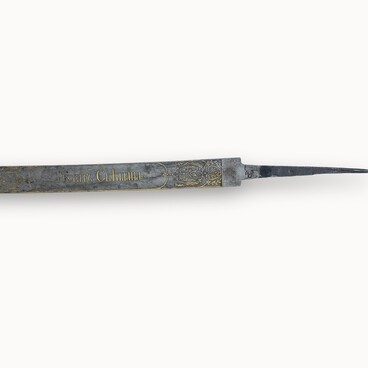Zlatoust bladed weapons had great combat qualities and were known far beyond Russia. Foreign craftsmen were invited for the manufacture of bladed weapons to be established, however, local workers began to manage on their own later. The factory had seven departments including those in charge of steel production and manufacture of blades, knives, hilts, and decorated weapons.
The permanent exhibition of the Zlatoust Museum of Local Lore has two naval boarding broadswords. The displayed item is an 1854 model blade. It was decorated with a very rare technique — openwork cutting. It was used exclusively at the weapons factory in Zlatoust.
The blade was made of Damascus steel in the second half of the 19th century. In fact, this Damascus steel is an artificial (or welded) bulat steel according to the classification proposed by Pavel Petrovich Anosov (1799, Saint Petersburg — 1851, Omsk). He was an outstanding Russian metallurgical scientist, a major organizer of the mining industry, and a researcher of the nature of the Southern Urals.
After graduating from the Saint Petersburg Mining Cadet Corps, Pavel Anosov worked in the Zlatoust Mining District from 1817 to 1847. Anosov’s most significant achievement in metallurgy was finding a new method for producing high-quality steels. He obtained various bulat steel patterns in Zlatoust in the 1840s and identified the way they depend on the properties of the metal.
The blade is decorated with a 27-centimeter-long pattern of diamond-shaped through holes. The edges of the holes are gilded. On the right side, a double-headed eagle, the coat of arms of the Russian Empire, is enclosed in the ornament.
This exhibit has no hilt. This means that the craftsmen actually made two specimens. One was finished and sent to a private customer. As for this one, it was intended for the collection of the arsenal of the Zlatoust Arms Factory. For the sake of economy, such blades were made with no hilts or scabbards. Similar cut-through blades were very rare, and the patterns on them were unique.
The permanent exhibition of the Zlatoust Museum of Local Lore has two naval boarding broadswords. The displayed item is an 1854 model blade. It was decorated with a very rare technique — openwork cutting. It was used exclusively at the weapons factory in Zlatoust.
The blade was made of Damascus steel in the second half of the 19th century. In fact, this Damascus steel is an artificial (or welded) bulat steel according to the classification proposed by Pavel Petrovich Anosov (1799, Saint Petersburg — 1851, Omsk). He was an outstanding Russian metallurgical scientist, a major organizer of the mining industry, and a researcher of the nature of the Southern Urals.
After graduating from the Saint Petersburg Mining Cadet Corps, Pavel Anosov worked in the Zlatoust Mining District from 1817 to 1847. Anosov’s most significant achievement in metallurgy was finding a new method for producing high-quality steels. He obtained various bulat steel patterns in Zlatoust in the 1840s and identified the way they depend on the properties of the metal.
The blade is decorated with a 27-centimeter-long pattern of diamond-shaped through holes. The edges of the holes are gilded. On the right side, a double-headed eagle, the coat of arms of the Russian Empire, is enclosed in the ornament.
This exhibit has no hilt. This means that the craftsmen actually made two specimens. One was finished and sent to a private customer. As for this one, it was intended for the collection of the arsenal of the Zlatoust Arms Factory. For the sake of economy, such blades were made with no hilts or scabbards. Similar cut-through blades were very rare, and the patterns on them were unique.




